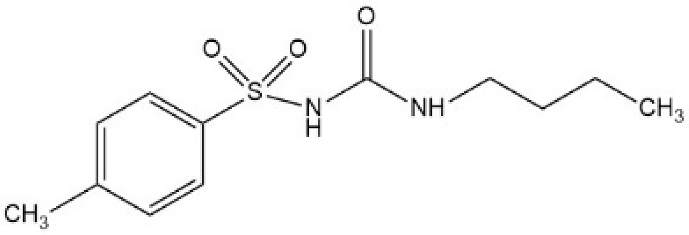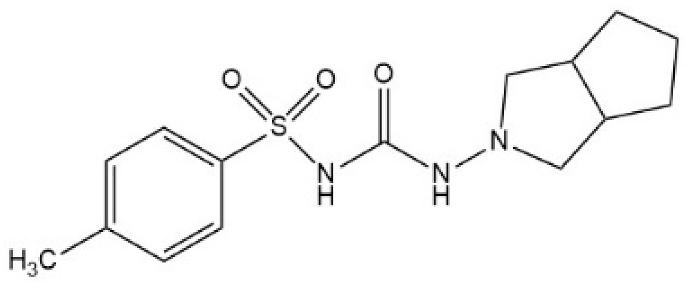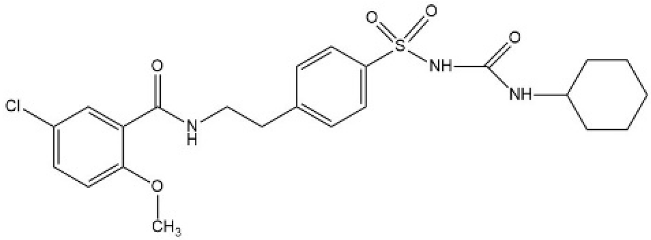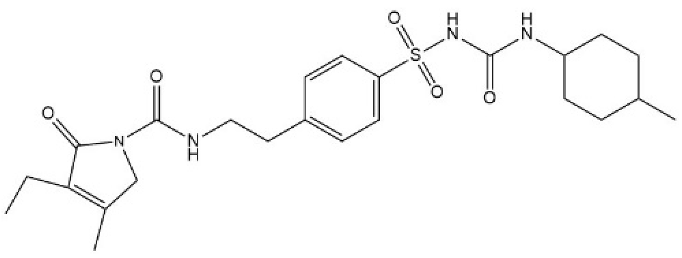Abstract
This article presents the current state of knowledge regarding electrochemical methods for determining the active substances within drugs that are used in the treatment of type 1 and type 2 diabetes. Electrochemical methods of analysis, due to their sensitivity and easiness, are a great alternative to other, usually more expensive analytical assays. The determination of active substances mentioned in this review is based on oxidation or reduction processes on the surface of the working electrode. A wide variety of working electrodes, often modified with materials such as nanoparticles or conducting polymers, have been used for the highly sensitive analysis of antidiabetic drugs. The presented assays allow us to determine the compounds of interest in various samples, such as pharmaceutical products or different human bodily fluids.
1. Introduction
Diabetes mellitus is defined as a group of metabolic disorders manifesting with hyperglycemia (elevated glucose levels in the blood) caused by defects in insulin secretion or action. The literature describes three main types of diabetes: type 1 diabetes mellitus (T1DM), type 2 diabetes mellitus (T2DM) and gestational diabetes. Statistics show that the most common type of diabetes is T2DM, also called non-insulin-dependent diabetes. According to the WHO (World Health Organization), approximately 422 million people worldwide suffer from diabetes, with over 95% being cases of T2DM [,,].
T1DM is considered an autoimmune disease, typically diagnosed in children and young adults. The disease is initiated when a patient’s immune system starts to destroy the β cells that are responsible for the regulation of glucose levels in the blood. The treatment of T1DM involves regular subcutaneous injections of insulin via a syringe or insulin pump, which should mimic normal pancreatic function. Non-insulin drugs are also used in T1DM therapy: amylin, pramlintide, metformin, GLP-1 receptor agonists and dipeptidyl peptidase-4 inhibitors [,,].
In T2DM, a patient’s body does not produce enough insulin and/or cells do not respond properly to the insulin, which leads to increased blood glucose levels. Unlike T1DM, it affects mostly adults. According to the literature, the development of the disease is caused by both genetic and environmental factors. Therapy for T2DM involves, above all, a change in lifestyle by means of introducing a healthy diet and physical activity. Nevertheless, in most patients, pharmacological treatment is also necessary. The following groups of medications are recommended: sulfonylurea derivatives, dipeptidyl peptidase-4 inhibitors, biguanide derivatives, GLP-1 receptor agonists, sodium–glucose cotransporter-2 inhibitors and α-glucosidase inhibitors. In some patients, therapy based on insulin may be used as well [,,].
The third common type of diabetes is gestational diabetes. It can develop during pregnancy in women who do not already suffer from diabetes. Pregnant women’s bodily changes include changing cell responses to the hormone that leads to the development of insulin resistance. According to recommendations, the treatment of gestational diabetes should be based on insulin injections [,,,].
Diabetes therapy most frequently involves the need to take medications on a daily basis. The effective control of glucose levels in the blood is crucial for the proper functioning and safety of patients. Therefore, the problem of quality control of the medications available on the pharmaceutical market is an important issue [].
After administration, drugs are metabolized in a patient’s body, excreted and then end up in sewage. In this context, a higher consumption of medications raises a new problem. Relatively high quantities of organic substances of medical origin end up in sewage. Unfortunately, the methods utilized in sewage treatment plants are not sufficient enough to remove that kind of contamination. After treatment, sewage is released to rivers, which means that, eventually, different types of organic compounds end up in the environment. Therefore, the branch of analytical chemistry is still growing in the search for new methods of disposing of drugs and determining their metabolites.
Electrochemical methods are a useful tool in qualitative and quantitative drug determination, especially those discussed in this work, which include voltammetry and amperometry. In these methods, the analytical signal is related to the redox reaction of the analyte on the surface of the working electrode. The electrons generated during the reaction initiate current flow, the quantity of which is proportional to the amount of the analyte in the system.
The most important part of each voltametric and amperometric measurement system is the working electrode. Different constructions and materials are used depending on the type of analyte, measurement conditions, etc. The most traditional and the oldest types of sensors are mercury electrodes. Taking into account the toxicity of the metal, modern constructions aim to limit the consumption of mercury while maintaining the benefits of using the mentioned metal as an electrode material. One example of such construction might be a renewable amalgam film electrode. The other group of working electrodes are solid electrodes, including metal electrodes (e.g., Ag, Au, Pt), glassy carbon electrodes (GCEs), carbon paste electrodes (CPEs), screen-printed electrodes (SPEs), graphite-based electrodes or boron-doped diamond electrodes (BDDEs). The current trend in electrochemistry is focused on modifications of solid electrodes (mostly GCEs, CPEs, SPEs) with surface modifiers. Such materials should be characterized by good electrical conductivity, a high surface area or electrocatalytic properties. The aim of surface modification is to improve the sensitivity and selectivity of the electrode.
Electrochemical methods are utilised for determination of both organic and inorganic substances in samples characterised by simple and complex matrices. It is a versatile tool characterised by relatively high precision and accuracy. The cost of purchasing and maintaining equipment is relatively low. Another advantage of voltammetry is the possibility to measure very low concentrations of an analyte. The limits of detection (LODs) for voltametric methods are often comparable to those achieved using more complex and more expensive chromatographic methods. Voltametric and amperometric measurements do not require toxic solvents and the consumption of chemicals is very low, which is consistent with principles of green chemistry.
Considering the above-mentioned problem of the increasing consumption of antidiabetic drugs and environmental pollution, it is extremely important to develop analytical methods that will allow for the monitoring of the quality of produced pharmaceuticals, as well as their presence in the environment. Electrochemical methods are a versatile and useful tool in drug analysis; therefore, this review is devoted to voltametric and amperometric assays of antidiabetic drugs.
2. Electrochemical Measurements of Antidiabetic Drugs
2.1. Insulin
Insulin is an anabolic peptide hormone with systemic action, which plays an essential role in the metabolism of carbohydrates, proteins and fats. Insulin is secreted by the endocrine part of the pancreas, more specifically by the beta cells of the Langerhans islets, which constitute 75% of all islet cells. This hormone belongs to the group of peptide hormones and is created as a result of the combination of 51 amino acid residues. The insulin molecule consists of two polypeptide chains, alpha (α) and beta (β). Insulin participates directly or indirectly in all links in the metabolism of carbohydrates, proteins and fats. The most important stimulus for insulin secretion is an increase in blood glucose concentration. Most body cells have insulin receptors on their surface. In type I diabetes, insulin treatment is necessary because the pancreas does not produce this hormone at all. However, with type II diabetes, patients may be able to maintain normal blood glucose levels with appropriate diet, exercise and antidiabetic medications. Only when these methods do not deliver the desired results is insulin introduced into the treatment [,,,,,].
Interest in the possibility of insulin electrochemical quantification is very high; therefore, a lot of assays have been presented in the literature. Most of them use some kind of modified electrodes as the sensing platform (Table 1). As the most popular modifier, carbon nanotubes are used, along with the metal nanoparticles or metal oxides [,,,]. One of the lowest insulin detection limits was obtained using screen-printed platinum electrodes modified with molecularly imprinted polymer nanoparticles (NanoMIP/SPPE, LOD 26 fM) [], and on the silver nanoflower-decorated, reduced graphene oxide-modified micro-disk electrode arrays (AgNF/rGO/MDEA, LOD 70 pg mL−1) []. Insulin has also been successfully measured both in pharmaceutical formulation and in real samples with complex matrices, such as human or animal bodily fluids (e.g., serum, plasma, urine).

Table 1.
Electrochemical methods of insulin determination.
2.2. Sulfonylurea Class of Antidiabetic Agents
Sulfonylureas (SUs) constitute the oldest class of drugs used for the treatment of type 2 diabetes mellitus, commercialized in the late 1950s. All pharmacological SUs contain a phenyl-sulphonyl-urea structure (Figure 1) with a p-substituent on the phenyl ring (R1) and various groups terminating the urea N end group (R2), which modulates their pharmacokinetic and pharmacotoxicological profile [].

Figure 1.
General structure formula of sulfonylureas.
Sulfonylureas are widely used to maintain an appropriate blood glucose level in patients with type II non-insulin-dependent diabetes mellitus. As a group of insulin secretagogues, SUs stimulate endogenous insulin release from beta cells of the pancreas regardless of blood glucose levels []. SUs also lead to increased glucose uptake and oxidation and decreased liver gluconeogenesis, and may cause increased insulin receptor numbers and sensitivity. The most common effect connected with the mechanism of action of SUs is hypoglycemia [].
Currently, several sulfonylureas are available for the treatment of type II diabetes mellitus. They are traditionally divided into two groups or generations of agents (Table 2). The first-generation sulfonylureas include chlorpropamide and tolbutamide, whereas gliclazide, glipizide, glibenclamide and glimepiride are second-generation sulfonylureas. As a result of being more potent and allowing administration at a lower, once-daily dose, the second-generation sulfonylureas have largely replaced the first-generation agents.

Table 2.
Comparison of sulfonylurea agents.
2.2.1. Gliclazide
For the voltametric determination of gliclazide (GLZ), different kinds of working electrodes have been implemented (Table 3). A CPE-based sensor, which exhibited a linear response of GLZ in the range of 5 × 10−7–1.25 × 10−6 mol L−1, with the LOD value equal to 1 × 10−7 mol L−1, was successfully applied in the determination of GLZ in tablets []. An improvement in the analytical performance of GLZ sensors was achieved through the application of various sensing materials, including an electropolymerized molecularly imprinted polymer (E-MIP) [], magnetic core–shell Fe3O4@SiO2 and multiwalled carbon nanotubes (MWCNTs) [], ZnIn2S4 nanoparticles [], MoWS2 [] and magnetic core–shell manganese ferrite nanoparticles (MCSNPs) [] in the modification of GCEs, CPEs and SPEs.

Table 3.
Electrochemical methods of gliclazide determination.
The high synergetic activity of ZnIn2S4 and ionic liquid (1-butyl-3-methylimidazolium hexafluorophosphate (BMIM.PF6)) resulted in the fabrication of a modified electrode (ZISILCPE) characterized by a wide linear range (7.5 × 10−7–5.0 × 10−4 mol L−1), low LOD (1.2 × 10−7 mol L−1) and applicability for the detection of GZL in pharmaceutical and urine samples in the presence of glibenclamide []. A simple, portable and sensitive sensor based on a MoWS2-modified screen-printed electrode (MoWS2/SPE) was fabricated and applied to the determination of GZL in biological and pharmaceutical samples. The utilization of a MoWS2 nanoparticle in the surface modification of the SPE resulted in an improvement in electron transfer rates, and thus an increase in sensitivity, which allowed one to obtain the LOD value of 1.8 × 10−8 mol L−1 [].
The most favorable analytical performances in terms of the precision, selectivity and sensitivity of GLZ voltametric determination was exhibited by the sensor-based GCE modified with an electropolymerized molecularly imprinted polymer (E-MIP) film. The obtained excellent LOD value of 1.2 × 10−11 mol L−1 resulted from the easier and faster accessibility of recognition sites due to the very thin structure of the sensing layer [].
2.2.2. Glipizide
Only a few reports regarding the voltametric determination of glipizide (GLP) have been described so far (Table 4) [,,,]. As the working electrodes, CPEs, HMDEs and in situ-plated lead firm electrodes were used. By applying a simple and precision square-wave adsorptive stripping voltametric technique, it was possible to develop a procedure of GLP determination with an advantageous limit of detection equal to 1.5 × 10−10 mol L−1 and 2.5 × 10−10 mol L−1 achieved for the HMDE and the lead film electrode, respectively. The presented sensors were successfully applied for the quantitation of glipizide in pharmaceutical formulations and human urine samples.

Table 4.
Electrochemical methods of glipizide determination.
2.2.3. Glibenclamide
As shown (Table 5), the electroanalytical determination of glibenclamide (GBC) through the voltametric methods can be performed with the use of HMDEs [], Sephadex-modified carbon paste electrodes (SMCPEs) [], and ZnIn2S4 nanoparticles with ionic liquid-modified carbon paste electrodes (ZISILCPEs) []. The strong binding between GBC molecules and the Sephadex polymer at the surface of SMCPEs allowed for the analysis of trace levels of glibenclamide by means of a stripping analysis. As a result, the GBC sensor with linear range of 1.0 × 10−9–5.0 × 10−8 mol L−1 and an LOD of 4 × 10−10 mol L−1 was developed and applied to for determination of glibenclamide in commercially available antidiabetic drugs and human serum []. A square-wave adsorptive cathodic stripping (SW-AdCS) voltametric procedure for the quantification of GBC with a similar analytical performance (linear range of 2 × 10−8–1 × 10−6 mol L−1 and LOD of 6 × 10−9) was developed with the Hg electrode [].

Table 5.
Electrochemical methods of glibenclamide determination.
2.2.4. Glimepiride
As reported in the literature, several papers have been published for the electrochemical detection of glimepiride (GLI) using various kinds of working electrode (Table 6). The vast majority of GLI voltametric sensors are based on the utilization of carbon-based electrodes, including carbon paste electrodes and glassy carbon electrodes [,,], as well as hanging drop mercury electrodes [,,,]. These papers have focused on understanding the electrochemical behavior of GLI at a particular sensor and its quantitative determination, either alone or in combination with other antidiabetic drugs. By applying various types of voltametric techniques (DPV, SWV, SW AdCSV), the limit of GLI detection in the range of 2 × 10−7 mol L−1 to 1.7 × 10−5 mol L−1 was achieved under optimized conditions.

Table 6.
Electrochemical methods of glimepiride determination.
2.3. Metformin
Metformin (MET), N,N-dimethylimidodicarbonimidic diamide, is one of the most common prescribed antidiabetic agents used for the treatment of type 2 diabetes mellitus (T2DM), or non-insulin-dependent diabetes. MET is an amino-group-rich compound with biguanide structures, containing two coupled molecules of guanidine with additional substitutions (Figure 2), which determine the blood-normalizing action of this drug. Physiologically, metformin directly or indirectly decreases glucose production in the liver, enhancing insulin sensitivity, and acts on the gut to increase glucose utilization []. MET can be used alone or in combination with other antidiabetic agents, such as sulfonylureas, alpha-glucosidase inhibitors or insulin []. It is an oral drug with a daily dosage ranging from 500 to 25,000 mg [].
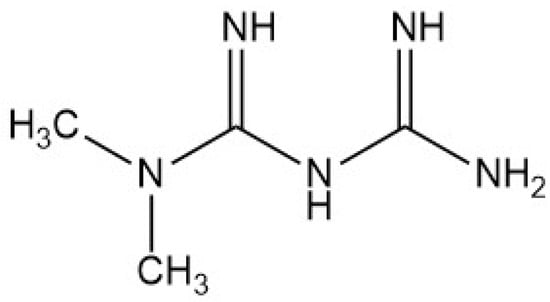
Figure 2.
Structure of metformin (molecular weight: 129.167 g/mol; molecular formula: C4H11N5).
The worldwide consumption of metformin has resulted in the development of many electrochemical methods for its sensitive and selective determination in pharmaceuticals, biological fluids and environmental samples (Table 7). Based on a catalytic hydrogen evolution reaction with a hanging mercury drop electrode (HMDE), the quantitative determination of MET was possible in the linear range of 0.1 to 2 µM, and the LOD was equal to 0.018 µM []. As a result of the toxicity of mercury, environmentally friendly electrodes have been used more frequently. According to data from the literature, the most popular MET voltametric sensors are composed of a carbon paste electrode (CPE). Significant improvements in the selectivity and selectivity of CPEs have been achieved through the introduction of various kinds of nanomaterials, such as Fe-Cu/TiO2 [], copper(II)-loaded activated charcoal [], γ-Fe2O3@ hydrohyapatite/Cu(II) magnetic nanocomposites [], sized mesoporous silica materials functionalized by copper ion [], pyrogallol [], molecular wires containing copper(II) and multiwalled carbon nanotubes [], copper–graphene nanocomposites [] and nickel oxide nanotube/carbon microparticle/Nafion composites []. Most of these constructions are based on the utilization of materials containing copper, which reacts with metformin, forming an electro-active complex determined voltammetrically. The catalytic action of cooper(II) ions on the electrochemical oxidation of metformin leads to fabrication, i.a. Fe-Cu/TiO2/CPE [] and Cu-AC-CPE [] are characterized by some of the lowest LOD values reported in the literature, equal to 3 nM and 9 nM, respectively. The possibility of the low-level determination of MET by these sensors has found applications in biological fluids, such as urine.

Table 7.
Electrochemical methods of metformin determination.
2.4. Dipeptidyl Peptidase-4 Inhibitor
The action of drugs from this group is to quickly and completely inhibit the activity of dipeptidyl peptidase-4 inhibitor (DPP-4), which contributes to the inactivation of endogenous glucagon-like peptide 1 (GLP-1). This causes an increase in the concentration of endogenous incretins, GLP-1 and GIP (gastric inhibitory peptide), on an empty stomach and after a meal. The effect on the pancreas is similar to the action of GLP-1 mimetics, but drugs from this group usually do not slow down emptying the stomach or clinically significant weight loss. They stimulate the secretion of insulin when needed (after a meal), have a protective effect on pancreatic β cells and have a positive effect on cholesterol levels. They are recommended for overweight and obese people and are intended for the treatment of type 2 diabetes. These drugs are administered orally, once a day at a fixed time, regardless of the meal. Gliptins can be used alone or in combination with metformin, sulfonylureas or thiazolidinedione derivatives [,,,,,,,].
2.4.1. Sitagliptin
Sitagliptin (STG) (Figure 3) inhibits the breakdown of incretin hormones in the body. These hormones stimulate the pancreas to produce insulin. By prolonging the action of incretin hormones in the blood, sitagliptin stimulates the pancreas to produce more insulin when glucose levels are high. It also reduces the amount of glucose produced by the liver by increasing insulin levels and decreasing the level of a hormone called glucagon. Together, these processes reduce blood glucose levels and help to control type 2 diabetes [,,,].
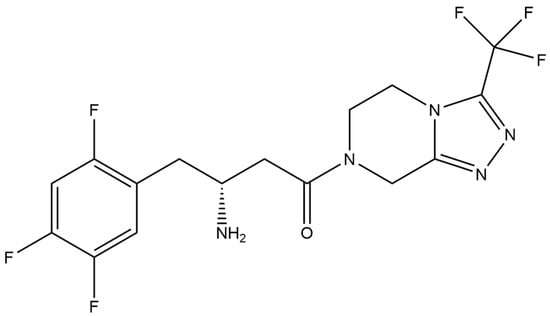
Figure 3.
Structure of sitagliptin (molecular weight: 523.32 g mol−1; molecular formula: C16H15F6N5O).
There are not many electrochemical assays of sitagliptin reported in the current literature (Table 8). Both of them use the differential pulse voltammetry technique as the determination method. The lowest obtained detection limit was equal to 0.06 pM on the screen-printed platinum electrode modified with molecularly imprinted polymer nanoparticles immobilized on its surface []. The proposed method has been successfully applied to the determination of STG in plasma samples. Another reported assay used a hanging mercury drop electrode as the working electrode, which allowed the authors to obtain LOD parameters as low as 2.6 nM, and the method has been applied to STG determination in pharmaceutical products [].

Table 8.
Electrochemical methods of sitagliptin determination.
2.4.2. Linagliptin
Linagliptin (Figure 4) is an organic chemical compound from the group of dipeptidyl peptidase-4 inhibitors. It is used in type 2 diabetes to improve glycemic control. Linagliptin, in a glucose-dependent manner, increases insulin secretion and reduces glucagon secretion, thus allowing for an overall improvement in glucose homeostasis. Linagliptin can be used both in monotherapy and also in combination with metformin and sulfonylurea derivatives. The side effects of linagliptin intake may include nose and throat inflammation and, in some cases, angioedema, pancreatitis and joint pain. The administration of linagliptin is not recommended for women who are pregnant or breastfeeding.
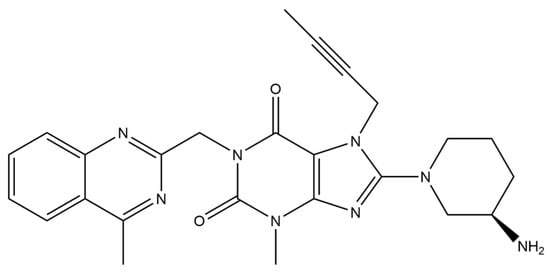
Figure 4.
Structure of linagliptin (molecular weight: 472.54 g mol−1; molecular formula: C25H28N8O2).
Among the electrochemical methods for linagliptin determination, the most popular are voltametric techniques, such as differential pulse voltammetry and square-wave voltammetry (Table 9). In most cases, modified solid electrodes were chosen as the sensing elements. As a modifier, carbon nanotubes and metal oxides were commonly used. The lowest LOD was obtained for the carbon paste electrode modified with molecularly imprinted poly-itaconic and multiwalled carbon nanotubes, equal to 1 × 10−13 M []. The proposed method was successfully applied for highly sensitive linagliptin determination in complex matrices, such as pharmaceutical formulations in the form of tablets, urine and serum samples.

Table 9.
Electrochemical methods of linagliptin determination.
2.4.3. Vildagliptin
Vildagliptin (Figure 5) is an antidiabetic drug that belongs to the group of incretin drugs. Incretins are hormones produced in intestinal cells that, in response to the presence of food substances in the digestive tract, increase insulin secretion via Langerhans islets beta cells in the pancreas; these include glucagon-like peptide 1 (GLP-1) and glucose-dependent insulinotropic peptide (GIP, also called gastric inhibitory peptide). Incretin drugs mimic the action of incretins or increase their concentration by inhibiting the enzymes that break them down. Vildagliptin belongs to the second group mentioned. These are dipeptidyl peptidase IV (DPP-4) inhibitors, the so-called gliptin. They increase the concentration of incretins by inhibiting the enzyme that breaks down these hormones. There is an increase in the concentration of glucagon-like peptide 1 and glucose-dependent insulinotropic peptide, which improves the sensitivity of beta cells of the islets of Langerhans of the pancreas to glucose, increases insulin secretion and improves the activity of alpha cells responsible for the production of glucagon, without disturbing the glucagon response to hypoglycemia. Drugs from this group also do not cause weight gain. The indication for the use of vildagliptin is monotherapy for type 2 diabetes or combination therapy with another oral antidiabetic drug.
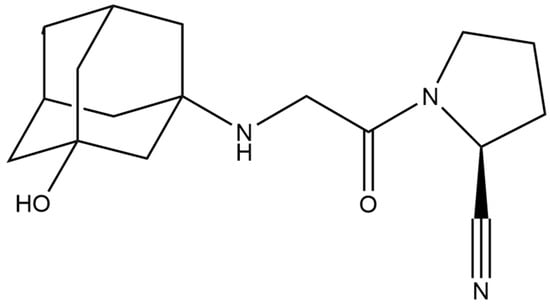
Figure 5.
Structure of vildagliptin (molecular weight: 303.406 g mol−1; molecular formula: C17H25N3O2).
Vildagliptin was measured electrochemically, mainly using the square-wave voltammetry technique (Table 10). A wide variety of working electrodes was used, including boron-doped diamond electrodes, pencil graphite electrodes and platinum electrodes. Additionally, a modification of the carbon paste electrode was used in the form of mixing the carbon paste with calcium and montmorillonite clay. As a result, the lowest LOD obtained was equal to 77.52 nM []. Vildagliptin was successfully determined in matrices such as pharmaceutical formulations in the form of tablets, human serum and urine, and also in the cell lines.

Table 10.
Electrochemical methods of vildagliptin determination.
2.5. Thiazolidinedione Derivatives
Thiazolidinedione derivatives (glitazones) are selective agonists of peroxisome proliferator-activated nuclear receptors (PPAR-γ), which are found mainly in adipose tissue, muscle and liver. The stimulation of these receptors leads to the transcription of genes responsible for the production, transport and metabolism of glucose and fatty acids. Glitazones reduce both fasting and postprandial glycemia without the risk of hypoglycemia. The favorable metabolic profile of these drugs results from increased tissue sensitivity to insulin, reduced insulin resistance in adipose tissue and a decrease in the concentration of free fatty acids and glucose in the blood [,,,,].
2.5.1. Pioglitazone
Pioglitazone (PIO) (Figure 6) improves the sensitivity of peripheral tissues to insulin, controls glycemia, dyslipidemia and hypertension, and also reduces albuminuria in patients with type 2 diabetes. Reducing glycemia, both fasting and postprandial, occurs mainly due to hepatic and peripheral (muscle) reduction in insulin resistance. Moreover, pioglitazone has proven to be effective not only in the treatment of type 2 diabetes, but also in preventing its development. Pioglitazone activates peroxisome proliferator-activated receptors (PPAR-γ), and causes a decrease in the insulin resistance of muscle and adipose tissue and a decrease in gluconeogenesis in the liver. The effect of pioglitazone is to reduce glycemia, insulinemia and triglycerides, and increase the HDL cholesterol fraction in the blood. Pioglitazone does not increase insulin secretion and acts only in its presence, and does not cause hypoglycemia [,,,,,,].

Figure 6.
Structure of pioglitazone (molecular weight: 356.44 g mol−1; molecular formula: C19H20N2O3S).
A variety of electrochemical techniques among the different types of working electrodes were implemented for highly sensitive pioglitazone determination (Table 11). Aside from the classic construction of the hanging mercury drop electrode, mainly solid electrodes and carbon paste electrodes were used for this matter. The lowest reported PIO detection limit was obtained using the HMDE electrode, and it was equal to 8.08 nM. Other reported assays include the usage of glassy carbon electrodes, on which the lowest LOD was of about 0.07 µM, or screen-printed graphite electrodes, with the LOD parameter equal to 29 nM. In order to check the possibilities of the proposed methods for routine quality control analysis, PIO measurements were performed on pharmaceuticals and serum samples.

Table 11.
Electrochemical methods of pioglitazone determination.
2.5.2. Rosiglitazone
Rosiglitazone (Figure 7) is an organic chemical compound, a drug used in the treatment of diabetes, belonging to the thiazolidinedione group of oral hypoglycemic drugs. It is a selective agonist of the nuclear peroxisome proliferator-activated receptor γ (PPAR-γ), located at the border of the cell nucleus and cytoplasm. Activation of the PPAR-γ receptor leads to the transcription of genes involved in the synthesis, transport and utilisation processes of glucose and the regulation of the metabolism of fatty acids. By acting on PPAR-γ, rosiglitazone reduces insulin resistance in adipocytes, skeletal muscle myocytes and hepatocytes. The drug reduces insulinemia, the need for endogenous insulin and the concentration of free fatty acids and glucose in the blood.

Figure 7.
Structure of rosiglitazone (molecular weight: 357.43 g mol−1; molecular formula: C19H20N2O3S).
Among the reported methods of rosiglitazone determination, a few voltametric assays were presented (Table 12). As the working electrode, classic mercury electrodes were used, including dropping mercury electrodes or the hanging mercury drop electrodes. In addition, carbon electrodes, such as glassy carbon electrodes and carbon paste electrodes, were used in this respect. Rosiglitazone was successfully measured in matrices such as pharmaceutical formulations, human urine and plasma. Under optimised conditions, the LOD of rosiglitazone was specified as 3.2 × 10−11 M.

Table 12.
Electrochemical methods of rosiglitazone determination.
2.6. Repaglinide
Repaglinide (Figure 8) is an organic chemical compound, an antidiabetic and hypoglycemic drug. It is a short-acting hypoglycemic drug that belongs to carbamoylbenzoic acid derivatives from the group of drugs known as meglitinides, which were invented in 1983. Its proven mechanism of action is to stimulate insulin release from pancreatic β cells by inhibiting ATP-dependent potassium channels. The main side effect is the possibility of hypoglycemia. In type 2 diabetes, this drug quickly corrects the disorder of meal-stimulated insulin secretion, without increasing the secretion of the hormone between meals and at night. This allows a patient treated with repaglinide to eat meals in a rhythm that is customised to individual needs while reducing the risk of hypoglycemia.
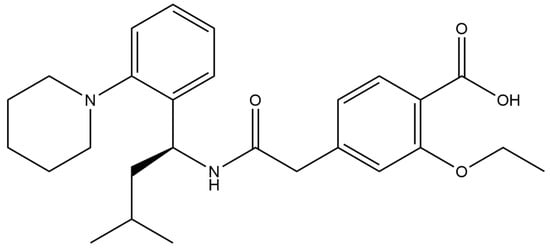
Figure 8.
Structure of repaglinide (molecular weight: 452.595 g mol−1; molecular formula: C27H36N2O4).
Differential pulse and square-wave voltammetry was successfully applied to the highly sensitive determination of repaglinide, mostly in pharmaceutical samples in the form of tablets, but studies on serum and urine were also performed (Table 13). However, bare glassy carbon electrodes and carbon paste electrodes were successfully used for repaglinide determination [,]; the usage of modification layers led to obtaining better results considering the linearity range and limits of detection. The lowest LOD was obtained using glassy carbon electrodes modified with a composite of three-dimensional porous reduced graphene oxide nanostructures and SnO2 nanoparticles [].

Table 13.
Electrochemical methods of repaglinide determination.
3. Conclusions
Pharmacotherapy for diabetes with injective and oral hypoglycemic drugs has never been as broad and effective as it is today. It allows for the individualisation of treatment in most patients, the gain of control over the disease and the prevention of its complications. This review summarises the current state of knowledge in the field of electrochemical techniques used for determination of antidiabetic active substances in different matrices. Due to their simplicity, portability and easiness, electrochemical sensors have found a unique place in this matter, and the number of new proposed assays is still growing. It has also been proven that the proposed methods are suitable for the quality control analysis of pharmaceutical products and, in some cases, for monitoring drug concentrations in human bodily fluids.
Author Contributions
Conceptualization, J.S.; writing—original draft preparation, K.F., A.G.-R. and J.S.; writing—review and editing, K.F., A.G.-R. and J.S.; supervision, J.S.; project administration, J.S.; funding acquisition, K.F., A.G-R. and J.S. All authors have read and agreed to the published version of the manuscript.
Funding
This publication was financed by subsidy No. 16.16.160.557 of the Polish Ministry of Science and Education.
Institutional Review Board Statement
Not applicable.
Informed Consent Statement
Not applicable.
Data Availability Statement
No new data were created or analysed in this study. Data sharing is not applicable to this article.
Conflicts of Interest
The authors declare no conflict of interest.
References
- World Health Organization. WHO Diabetes Report; World Health Organization: Geneva, Switzerland, 2016. [Google Scholar]
- Sarwar, N.; Gao, P.; Seshasai, S.R.; Gobin, R.; Kaptoge, S.D.A. Diabetes Mellitus, Fasting Blood Glucose Concentration, and Risk of Vascular Disease: A Collaborative Meta-Analysis of 102 Prospective Studies. Emerging Risk Factors Collaboration. Lancet 2010, 26, 2215–2222. [Google Scholar]
- Global Burden of Disease Study 2019. Results. Institute for Health Metrics and Evaluation. Available online: https://vizhub.healthdata.org/gbd-results/ (accessed on 14 October 2023).
- Jean-Marie, E. Diagnosis and Classification of Diabetes Mellitus, 2nd ed.; Elsevier Inc.: Amsterdam, The Netherlands, 2018; ISBN 9780128122006. [Google Scholar]
- Kim, W.; Egan, J.M. The Role of Incretins in Glucose Homeostasis and Diabetes Treatment. Pharmacol. Rev. 2008, 60, 470–512. [Google Scholar] [CrossRef] [PubMed]
- Mogensen, C.E. New Treatment Guidelines for a Patient with Diabetes and Hypertension. J. Hypertens. Suppl. 2003, 21, S25–S30. [Google Scholar] [PubMed]
- Marín-Peñalver, J.J.; Martín-Timón, I.; Sevillano-Collantes, C.; Cañizo-Gómez, F.J. del Update on the Treatment of Type 2 Diabetes Mellitus. World J. Diabetes 2016, 7, 354. [Google Scholar] [CrossRef] [PubMed]
- Robertson, R.P. Diabetes Type 2 (Noninsulin-Dependent Diabetes Mellitus); Elsevier: Amsterdam, The Netherlands, 2016; Volume 2, ISBN 9780128093245. [Google Scholar]
- Blonde, L. Current Antihyperglycemic Treatment Guidelines and Algorithms for Patients with Type 2 Diabetes Mellitus. Am. J. Med. 2010, 123, S12–S18. [Google Scholar] [CrossRef] [PubMed]
- Kampmann, U. Gestational Diabetes: A Clinical Update. World J. Diabetes 2015, 6, 1065. [Google Scholar] [CrossRef] [PubMed]
- Catalano, P.M. Trying to Understand Gestational Diabetes. Diabet. Med. 2014, 31, 273–281. [Google Scholar] [CrossRef]
- McIntyre, H.D.; Catalano, P.; Zhang, C.; Desoye, G.; Mathiesen, E.R.; Damm, P. Gestational Diabetes Mellitus. Nat. Rev. Dis. Prim. 2019, 5, 47. [Google Scholar] [CrossRef]
- Coustan, D.R. Gestational Diabetes Mellitus. Clin. Chem. 2013, 59, 1310–1321. [Google Scholar] [CrossRef]
- Born, G.V.R.; Cuatrecasas, P.; Arbor, A.; Ganten, D.; Herken, H.; Melmon, K.L. Oral Antidiabetics; Springer: Berlin/Heidelberg, Germany, 1990; ISBN 3540212426. [Google Scholar]
- Rahman, M.S.; Hossain, K.S.; Das, S.; Kundu, S.; Adegoke, E.O.; Rahman, M.A.; Hannan, M.A.; Uddin, M.J.; Pang, M.G. Role of Insulin in Health and Disease: An Update. Int. J. Mol. Sci. 2021, 22, 6403. [Google Scholar] [CrossRef]
- Gutch, M.; Kumar, S.; Razi, S.M.; Gupta, K.; Gupta, A. Assessment of Insulin Sensitivity/Resistance. Indian J. Endocrinol. Metab. 2015, 19, 160–164. [Google Scholar] [CrossRef] [PubMed]
- Wilcox, G. Insulin and Insulin Resistance. Clin. Biochem. Rev. 2005, 26, 19–39. [Google Scholar] [CrossRef] [PubMed]
- Cheatham, B.; Kahn, C.R. Insulin Action and the Insulin Signaling Network*. Endocr. Rev. 1995, 16, 117–142. [Google Scholar] [CrossRef] [PubMed]
- Boucher, J.; Kleinridders, A.; Kahn, C.R. Insulin Receptor Signaling in Normal. Cold Spring Harb. Perspect. Biol. 2014, 6, a009191. [Google Scholar] [CrossRef] [PubMed]
- Petersen, M.C.; Shulman, G.I. Mechanisms of Insulin Action and Insulin Resistance. Physiol. Rev. 2018, 98, 2133–2223. [Google Scholar] [CrossRef] [PubMed]
- Arvinte, A.; Westermann, A.C.; Sesay, A.M.; Virtanen, V. Electrocatalytic Oxidation and Determination of Insulin at CNT-Nickel-Cobalt Oxide Modified Electrode. Sens. Actuators B Chem. 2010, 150, 756–763. [Google Scholar] [CrossRef]
- Pikulski, M.; Gorski, W. Iridium-Based Electrocatalytic Systems for the Determination of Insulin. Anal. Chem. 2000, 72, 2696–2702. [Google Scholar] [CrossRef] [PubMed]
- Salimi, A.; Noorbakhash, A.; Sharifi, E.; Semnani, A. Highly Sensitive Sensor for Picomolar Detection of Insulin at Physiological PH, Using GC Electrode Modified with Guanine and Electrodeposited Nickel Oxide Nanoparticles. Biosens. Bioelectron. 2008, 24, 792–798. [Google Scholar] [CrossRef]
- Yu, Y.; Guo, M.; Yuan, M.; Liu, W.; Hu, J. Nickel Nanoparticle-Modified Electrode for Ultra-Sensitive Electrochemical Detection of Insulin. Biosens. Bioelectron. 2016, 77, 215–219. [Google Scholar] [CrossRef]
- Zidarič, T.; Majer, D.; Maver, T.; Finšgar, M.; Maver, U. The Development of an Electropolymerized, Molecularly Imprinted Polymer (MIP) Sensor for Insulin Determination Using Single-Drop Analysis. Analyst 2023, 148, 1102–1115. [Google Scholar] [CrossRef]
- Yagati, A.K.; Choi, Y.; Park, J.; Choi, J.W.; Jun, H.S.; Cho, S. Silver Nanoflower-Reduced Graphene Oxide Composite Based Micro-Disk Electrode for Insulin Detection in Serum. Biosens. Bioelectron. 2016, 80, 307–314. [Google Scholar] [CrossRef] [PubMed]
- Habibi, E.; Omidinia, E.; Heidari, H.; Fazli, M. Flow Injection Amperometric Detection of Insulin at Cobalt Hydroxide Nanoparticles Modified Carbon Ceramic Electrode. Anal. Biochem. 2016, 495, 37–41. [Google Scholar] [CrossRef] [PubMed]
- Salimi, A.; Pourbeyram, S.; Haddadzadeh, H. Sol-Gel Derived Carbon Ceramic Composite Electrode Containing a Ruthenium Complex for Amperometric Detection of Insulin at Physiological PH. J. Electroanal. Chem. 2003, 542, 39–49. [Google Scholar] [CrossRef]
- Wang, J.; Zhang, X. Needle-Type Dual Microsensor for the Simultaneous Monitoring of Glucose and Insulin. Anal. Chem. 2001, 73, 844–847. [Google Scholar] [CrossRef] [PubMed]
- Wang, J.; Tangkuaram, T.; Loyprasert, S.; Vazquez-Alvarez, T.; Veerasai, W.; Kanatharana, P.; Thavarungkul, P. Electrocatalytic Detection of Insulin at RuOx/Carbon Nanotube-Modified Carbon Electrodes. Anal. Chim. Acta 2007, 581, 1–6. [Google Scholar] [CrossRef] [PubMed]
- Rafiee, B.; Fakhari, A.R. Electrocatalytic Oxidation and Determination of Insulin at Nickel Oxide Nanoparticles-Multiwalled Carbon Nanotube Modified Screen Printed Electrode. Biosens. Bioelectron. 2013, 46, 130–135. [Google Scholar] [CrossRef] [PubMed]
- Salimi, A.; Mohamadi, L.; Hallaj, R.; Soltanian, S. Electrooxidation of Insulin at Silicon Carbide Nanoparticles Modified Glassy Carbon Electrode. Electrochem. Commun. 2009, 11, 1116–1119. [Google Scholar] [CrossRef]
- Jaafariasl, M.; Shams, E.; Amini, M.K. Silica Gel Modified Carbon Paste Electrode for Electrochemical Detection of Insulin. Electrochim. Acta 2011, 56, 4390–4395. [Google Scholar] [CrossRef]
- Cheng, L.; Pacey, G.E.; Cox, J.A. Carbon Electrodes Modified with Ruthenium Metallodendrimer Multilayers for the Mediated Oxidation of Methionine and Insulin at Physiological PH. Anal. Chem. 2001, 73, 5606–5610. [Google Scholar] [CrossRef]
- Zhang, M.; Mullens, C.; Gorski, W. Insulin Oxidation and Determination at Carbon Electrodes. Anal. Chem. 2005, 77, 6396–6401. [Google Scholar] [CrossRef]
- Lu, L.; Liang, L.; Xie, Y.; Tang, K.; Wan, Z.; Chen, S. A Nickel Nanoparticle/Carbon Nanotube-Modified Carbon Fiber Microelectrode for Sensitive Insulin Detection. J. Solid State Electrochem. 2018, 22, 825–833. [Google Scholar] [CrossRef]
- Amini, N.; Gholivand, M.B.; Shamsipur, M. Electrocatalytic Determination of Traces of Insulin Using a Novel Silica Nanoparticles-Nafion Modified Glassy Carbon Electrode. J. Electroanal. Chem. 2014, 714–715, 70–75. [Google Scholar] [CrossRef]
- Wang, J.; Musameh, M. Electrochemical Detection of Trace Insulin at Carbon-Nanotube-Modified Electrodes. Anal. Chim. Acta 2004, 511, 33–36. [Google Scholar] [CrossRef]
- Noorbakhsh, A.; Alnajar, A.I.K. Antifouling Properties of Reduced Graphene Oxide Nanosheets for Highly Sensitive Determination of Insulin. Microchem. J. 2016, 129, 310–317. [Google Scholar] [CrossRef]
- Martínez-Periñán, E.; Revenga-Parra, M.; Gennari, M.; Pariente, F.; Mas-Ballesté, R.; Zamora, F.; Lorenzo, E. Insulin Sensor Based on Nanoparticle-Decorated Multiwalled Carbon Nanotubes Modified Electrodes. Sens. Actuators B Chem. 2016, 222, 331–338. [Google Scholar] [CrossRef]
- Kouchakinejad, S.; Babaee, S.; Roshani, F.; Kouchakinejad, R.; Shirmohammadi, N.; Kaki, S. The Performance of the New Modified Pencil Graphite Electrode in Quantifying of Insulin. Chem. Phys. Lett. 2020, 759, 137987. [Google Scholar] [CrossRef]
- Businova, P.; Prasek, J.; Chomoucka, J.; Drbohlavova, J.; Pekarek, J.; Hrdy, R.; Hubalek, J. Voltammetric Sensor for Direct Insulin Detection. In Proceedings of the Procedia Engineering; Elsevier Ltd.: Amsterdam, The Netherlands, 2012; Volume 47, pp. 1235–1238. [Google Scholar]
- Salimi, A.; Hallaj, R. Cobalt Oxide Nanostructure-Modified Glassy Carbon Electrode as a Highly Sensitive Flow Injection Amperometric Sensor for the Picomolar Detection of Insulin. J. Solid State Electrochem. 2012, 16, 1239–1246. [Google Scholar] [CrossRef]
- Shepa, J.; Šišoláková, I.; Vojtko, M.; Trnková, L.; Nagy, G.; Maskaľová, I.; Oriňak, A.; Oriňaková, R. Nio Nanoparticles for Electrochemical Insulin Detection. Sensors 2021, 21, 5063. [Google Scholar] [CrossRef]
- Garcia Cruz, A.; Haq, I.; Cowen, T.; Di Masi, S.; Trivedi, S.; Alanazi, K.; Piletska, E.; Mujahid, A.; Piletsky, S.A. Design and Fabrication of a Smart Sensor Using in Silico Epitope Mapping and Electro-Responsive Imprinted Polymer Nanoparticles for Determination of Insulin Levels in Human Plasma. Biosens. Bioelectron. 2020, 169, 112536. [Google Scholar] [CrossRef]
- Asadpour, F.; Mazloum-Ardakani, M.; Hoseynidokht, F.; Moshtaghioun, S.M. In Situ Monitoring of Gating Approach on Mesoporous Silica Nanoparticles Thin-Film Generated by the EASA Method for Electrochemical Detection of Insulin. Biosens. Bioelectron. 2021, 180, 113124. [Google Scholar] [CrossRef]
- Kouhdareh, J.; Karimi-Nami, R.; Keypour, H.; Rabiei, K.; Alavinia, S.; Saremi, S.G.; Noroozi, M. Synthesis of a Au/Au NPs-PPy/l-CYs/ZIF-8 Nanocomposite Electrode for Voltammetric Determination of Insulin in Human Blood. RSC Adv. 2023, 13, 24474–24486. [Google Scholar] [CrossRef] [PubMed]
- Cho, I.H.; Choi, K.J.; Choi, J.; Lee, K.; Ly, S.Y. Trace Assay of Insulin in a Pharmacy Drug with a Paste Electrode. Amino Acids 2022, 55, 1279–1284. [Google Scholar] [CrossRef] [PubMed]
- Lin, Y.; Hu, L.; Li, L.; Wang, K. Facile Synthesis of Nickel Hydroxide-Graphene Nanocomposites for Insulin Detection with Enhanced Electro-Oxidation Properties. RSC Adv. 2014, 4, 46208–46213. [Google Scholar] [CrossRef]
- Ensafi, A.A.; Khoddami, E.; Rezaei, B. Aptamer@Au-o-Phenylenediamine Modified Pencil Graphite Electrode: A New Selective Electrochemical Impedance Biosensor for the Determination of Insulin. Colloids Surf. B Biointerfaces 2017, 159, 47–53. [Google Scholar] [CrossRef] [PubMed]
- Kaur, A.; Verma, N. Electrochemical Biosensor for Monitoring Insulin in Normal Individuals and Diabetic Mellitus Patients. Eur. J. Exp. Biol. 2012, 2, 389–395. [Google Scholar]
- Müller, G. The Molecular Mechanism of the Insulin-Mimetic/Sensitizing Activity of the Antidiabetic Sulfonylurea Drug Amaryl. Mol. Med. 2000, 6, 907–933. [Google Scholar] [CrossRef] [PubMed]
- Van Staa, T.; Abenhaim, L.; Monette, J. Rates of Hypoglycemia in Users of Sulfonylureas. J. Clin. Epidemiol. 1997, 50, 735–741. [Google Scholar] [CrossRef] [PubMed]
- Radi, A.; El Ries, M.A.; Bekhiet, G.E. Electrochemical Oxidation of the Hypoglycaemic Drug Gliclazide. Anal. Lett. 1999, 32, 1603–1612. [Google Scholar] [CrossRef]
- Hrichi, H.; Louhaichi, M.R.; Monser, L.; Adhoum, N. Gliclazide Voltammetric Sensor Based on Electropolymerized Molecularly Imprinted Polypyrrole Film onto Glassy Carbon Electrode. Sens. Actuators B Chem. 2014, 204, 42–49. [Google Scholar] [CrossRef]
- Ganjali, M.R.; Salimi, H.; Tajik, S.; Beitollahi, H.; Badiei, A.; Ziarani, G.M. Electrochemical Determination of Gliclazide on Magnetic Coreshell Fe3O4@SiO2 Functionalized Multiwall Carbon Nanotubes Modified Glassy Carbon Electrode. Int. J. Electrochem. Sci. 2017, 12, 8868–8877. [Google Scholar] [CrossRef]
- Pourtaheri, E.; Taher, M.A.; Ali, G.A.M.; Agarwal, S.; Gupta, V.K. Electrochemical Detection of Gliclazide and Glibenclamide on ZnIn2S4 Nanoparticles-Modified Carbon Ionic Liquid Electrode. J. Mol. Liq. 2019, 289, 111141. [Google Scholar] [CrossRef]
- Jahani, P.M.; Tajik, S.; Beitollahi, H.; Mohammadi, S.; Aflatoonian, M.R. Voltammetric Detection of Gliclazide and Glibenclamide with Graphite Screen-Printed Electrode Modified with Nanopetal-Structured MoWS2. Res. Chem. Intermed. 2020, 46, 837–852. [Google Scholar] [CrossRef]
- Tajik, S.; Mohammadi, S.Z.; Beitollahi, H. Sensitive Determination of Gliclazide in Tablets and Urine Using Modified Screen-Printed Electrodes. Port. Electrochim. Acta 2021, 39, 265–275. [Google Scholar] [CrossRef]
- Mohammadi, S.Z.; Tajik, S.; Tashakkorian, H.; Zhang, K.; Van Le, Q.; Saeidi, S.; Jang, H.W.; Shokouhimehr, M.; Peng, W. Voltammetric Determination of Antidiabetic Drug Gliclazide in the Presence of Glibenclamide in Real Samples. Int. J. Electrochem. Sci. 2020, 15, 8595–8611. [Google Scholar] [CrossRef]
- Ghoneim, E.M.; El-Attar, M.A.; Hammam, E.; Khashaba, P.Y. Stripping Voltammetric Quantification of the Anti-Diabetic Drug Glipizide in Bulk Form and Pharmaceutical Formulation. J. Pharm. Biomed. Anal. 2007, 43, 1465–1469. [Google Scholar] [CrossRef] [PubMed]
- Radi, A.; Wahdan, T.; El-Ghany, N.A. Electrochemical Oxidation of the Hypoglycaemic Drug Glipizide on Carbon Paste Electrode and Its Determination in Tablet Dosage Form. Chem. Anal. 2004, 49, 627–633. [Google Scholar]
- Radi, A.E.M.; Eissa, S.H. Voltammetric and Spectrophotometric Studies on the Inclusion Complex of Glipizide with β-Cyclodextrin. Eurasian J. Anal. Chem. 2011, 6, 13–21. [Google Scholar]
- Tyszczuk, K.; Korolczuk, M. In-Situ Plated Lead Film Electrode for Determination of Glipizide in Pharmaceutical Formulation and Human Urine. Chem. Anal. 2009, 54, 31–41. [Google Scholar]
- El-Attar, M.A.; Ghoneim, M.M. Electro-Reduction, Quantification and Pharmacokinetic Studies for the Anti-Hyperglycemic Drug Glibenclamide Using Stripping Voltammetric Method: Development and Validation. Egypt. J. Chem. 2021, 64, 2013–2024. [Google Scholar] [CrossRef]
- Radi, A. Voltammetric Study of Glibenclamide at Carbon Paste and Sephadex-Modified Carbon Paste Electrodes. Anal. Bioanal. Chem. 2004, 378, 822–826. [Google Scholar] [CrossRef]
- Radi, A.E.M.; Eissa, S.H. Electrochemical Study of Glimepiride and Its Complexation with β-Cyclodextrin. Collect. Czechoslov. Chem. Commun. 2011, 76, 13–25. [Google Scholar] [CrossRef][Green Version]
- Badawy, W.A.; El-Ries, M.A.; Mahdi, I.M. Electrochemical Determination of Some Antidiabetic Drugs for Type 2 Diabetic Patients. Talanta 2010, 82, 106–112. [Google Scholar] [CrossRef] [PubMed]
- Ali, M.N.M.; Mashkor, M.S. Cyclic Voltametric Determination of Anti Diabetic Drug (Amaryl) in Pharmaceuticals Formulation by Using Different Carbon Electrodes. Eurasia J. Biosci. 2020, 14, 7291–7295. [Google Scholar]
- Suslu, I.; Altinoz, S. Determination of Glimepiride in Pharmaceutical Formulations by Square Wave Voltammetric Method. Curr. Anal. Chem. 2011, 7, 333–340. [Google Scholar] [CrossRef]
- Salma, A.T.; Nawal, A.; Hanan, A.H. Kinetic and Spectrophotometry Methods for Determination of Two Hypoglycemic Drugs, Pioglitazone Hydrochloride and Glimepiride in Their Pharmaceutical Formulations. Res. J. Chem. Environ. 2011, 15, 963–972. [Google Scholar]
- Ahmed, S.A.; Gaber, A.A.A.; Rahim, A.M.A. Elaboration of Impregnated Guava Seed by Cu(II) for Fixing Glimepiride Using Square-Wave Adsorptive Stripping Voltammetry. J. Mater. Environ. Sci. 2019, 10, 163–169. [Google Scholar]
- Al-Rawi, A.M.; Agha, Y.Y.; Al-Hafidh, A.Z.; Al-Taee, A.T. Electrochemical Behavior of Valsartan, Glimepiride and Their Interaction with Each Other Using Square Wave Voltammetry. Rafidain J. Sci. 2019, 28, 64–75. [Google Scholar] [CrossRef]
- Rena, G.; Hardie, D.G.; Pearson, E.R. The Mechanisms of Action of Metformin. Diabetologia 2017, 60, 1577–1585. [Google Scholar] [CrossRef]
- Sattarahmady, N.; Heli, H.; Faramarzi, F. Nickel Oxide Nanotubes-Carbon Microparticles/Nafion Nanocomposite for the Electrooxidation and Sensitive Detection of Metformin. Talanta 2010, 82, 1126–1135. [Google Scholar] [CrossRef]
- Górska, A.; Paczosa-Bator, B.; Wyrwa, J.; Piech, R. New Electrochemical Sensor of Prolonged Application for Metformin Determination Based on Hydrated Ruthenium Dioxide-Carbon Black-Nafion Modified Glassy Carbon Electrode. Electroanalysis 2020, 32, 1875–1884. [Google Scholar] [CrossRef]
- Gholivand, M.B.; Shamsipur, M.; Paimard, G.; Feyzi, M.; Jafari, F. Synthesis of Fe-Cu/TiO2 Nanostructure and Its Use in Construction of a Sensitive and Selective Sensor for Metformin Determination. Mater. Sci. Eng. C 2014, 42, 791–798. [Google Scholar] [CrossRef] [PubMed]
- Gholivand, M.B.; Mohammadi-Behzad, L. Differential Pulse Voltammetric Determination of Metformin Using Copper-Loaded Activated Charcoal Modified Electrode. Anal. Biochem. 2013, 438, 53–60. [Google Scholar] [CrossRef] [PubMed]
- Mirzajani, R.; Karimi, S. Preparation of Γ-Fe2O3/Hydroxyapatite/Cu(II) Magnetic Nanocomposite and Its Application for Electrochemical Detection of Metformin in Urine and Pharmaceutical Samples. Sens. Actuators B Chem. 2018, 270, 405–416. [Google Scholar] [CrossRef]
- Dehdashtian, S.; Gholivand, M.B.; Shamsipur, M.; Karimi, Z. A Nano Sized Functionalized Mesoporous Silica Modified Carbon Paste Electrode as a Novel, Simple, Robust and Selective Anti-Diabetic Metformin Sensor. Sens. Actuators B Chem. 2015, 221, 807–815. [Google Scholar] [CrossRef]
- Attia, A.K.; Salem, W.M.; Mohamed, M.A. Voltammetric Assay of Metformin Hydrochloride Using Pyrogallol Modified Carbon Paste Electrode. Acta Chim. Slov. 2015, 62, 588–594. [Google Scholar] [CrossRef] [PubMed]
- Tian, X.J.; Song, J.F.; Luan, X.J.; Wang, Y.Y.; Shi, Q.Z. Determination of Metformin Based on Amplification of Its Voltammetric Response by a Combination of Molecular Wire and Carbon Nanotubes. Anal. Bioanal. Chem. 2006, 386, 2081–2086. [Google Scholar] [CrossRef] [PubMed]
- Hassasi, S.; Hassaninejad-Darzi, S.K.; Vahid, A. Production of Copper-Graphene Nanocomposite as a Voltammetric Sensor for Determination of Anti-Diabetic Metformin Using Response Surface Methodology. Microchem. J. 2022, 172, 106877. [Google Scholar] [CrossRef]
- Narang, J.; Malhotra, N.; Singhal, C.; Bhatia, R.; Kathuria, V.; Jain, M. Graphene Nanoflakes on Transparent Glass Electrode Sensor for Electrochemical Sensing of Anti-Diabetic Drug. Bioprocess Biosyst. Eng. 2017, 40, 537–548. [Google Scholar] [CrossRef]
- Nezhadali, A.; Khalili, Z. Computer-Aided Study and Multivariate Optimization of Nanomolar Metformin Hydrochloride Analysis Using Molecularly Imprinted Polymer Electrochemical Sensor Based on Silver Nanoparticles. J. Mater. Sci. Mater. Electron. 2021, 32, 27171–27183. [Google Scholar] [CrossRef]
- Skrzypek, S.; Mirčeski, V.; Ciesielski, W.; Sokołowski, A.; Zakrzewski, R. Direct Determination of Metformin in Urine by Adsorptive Catalytic Square-Wave Voltammetry. J. Pharm. Biomed. Anal. 2007, 45, 275–281. [Google Scholar] [CrossRef]
- Tian, X.J.; Song, J.F. Catalytic Action of Copper (II) Ion on Electrochemical Oxidation of Metformine and Voltammetric Determination of Metformine in Pharmaceuticals. J. Pharm. Biomed. Anal. 2007, 44, 1192–1196. [Google Scholar] [CrossRef]
- Machini, W.B.S.; Fernandes, I.P.G.; Oliveira-Brett, A.M. Antidiabetic Drug Metformin Oxidation and in Situ Interaction with DsDNA Using a DsDNA-Electrochemical Biosensor. Electroanalysis 2019, 31, 1977–1987. [Google Scholar] [CrossRef]
- Pathak, R.; Bridgeman, M.B. Dipeptidyl Peptidase-4 (DPP-4) Inhibitors In the Management of Diabetes. Pharm. Ther. 2010, 35, 509–513. [Google Scholar]
- Ahrén, B.; Schweizer, A.; Dejager, S.; Villhauer, E.B.; Dunning, B.E.; Foley, J.E. Mechanisms of Action of the Dipeptidyl Peptidase-4 Inhibitor Vildagliptin in Humans. Diabetes Obes. Metab. 2011, 13, 775–783. [Google Scholar] [CrossRef]
- Aschner, P.; Kipnes, M.S.; Lunceford, J.K.; Sanchez, M.; Mickel, C.; Williams-Herman, D.E.; Sitagliptin Study 021 Group. Effect of the Dipeptidyl Peptidase-4 Inhibitor Sitagliptin as Monotherapy on Glycemic Control in Patients With Type 2 Diabetes. Diabetes Care 2006, 29, 2632–2637. [Google Scholar] [CrossRef]
- Deacon, C.F.; Lebovitz, H.E. Comparative Review of Dipeptidyl Peptidase-4 Inhibitors and Sulphonylureas. Diabetes Obes. Metab. 2016, 18, 333–347. [Google Scholar] [CrossRef]
- Baetta, R.; Corsini, A. Pharmacology of Dipeptidyl Peptidase-4 Inhibitors. Drugs 2011, 71, 1441–1467. [Google Scholar] [CrossRef]
- Mulvihill, E.E.; Drucker, D.J. Pharmacology, Physiology, and Mechanisms of Action of Dipeptidyl Peptidase-4 Inhibitors. Endocr. Rev. 2014, 35, 992–1019. [Google Scholar] [CrossRef] [PubMed]
- Thornberry, N.A.; Gallwitz, B. Mechanism of Action of Inhibitors of Dipeptidyl-Peptidase-4 (DPP-4). Best Pract. Res. Clin. Endocrinol. Metab. 2009, 23, 479–486. [Google Scholar] [CrossRef] [PubMed]
- Deacon, C.F. Dipeptidyl Peptidase 4 Inhibitors in the Treatment of Type 2 Diabetes Mellitus. Nat. Rev. Endocrinol. 2020, 16, 642–653. [Google Scholar] [CrossRef] [PubMed]
- Lyseng-Williamson, K.A. Sitagliptin. Drugs 2007, 67, 587–597. [Google Scholar] [CrossRef] [PubMed]
- Scott, L.J. Sitagliptin: A Review in Type 2 Diabetes. Drugs 2017, 77, 209–224. [Google Scholar] [CrossRef] [PubMed]
- Green, J.B.; Bethel, M.A.; Armstrong, P.W.; Buse, J.B.; Engel, S.S.; Garg, J.; Josse, R.; Kaufman, K.D.; Koglin, J.; Korn, S.; et al. Effect of Sitagliptin on Cardiovascular Outcomes in Type 2 Diabetes. N. Engl. J. Med. 2015, 373, 232–242. [Google Scholar] [CrossRef] [PubMed]
- Drucker, D.; Easley, C.; Kirkpatrick, P. Sitagliptin. Nat. Rev. Drug Discov. 2007, 6, 109–111. [Google Scholar] [CrossRef] [PubMed]
- Haq, I.; Alanazi, K.; Czulak, J.; Di Masi, S.; Piletska, E.; Mujahid, A.; Hussain, T.; Piletsky, S.A.; Garcia-Cruz, A. Determination of Sitagliptin in Human Plasma Using a Smart Electrochemical Sensor Based on Electroactive Molecularly Imprinted Nanoparticles. Nanoscale Adv. 2021, 3, 4276–4285. [Google Scholar] [CrossRef] [PubMed]
- Górska, A.; Paczosa-Bator, B.; Piech, R. Highly Sensitive Adsorptive Stripping Voltammetric Method for Sitagliptin Determination on Renewable Amalgam Film Electrode. J. Electrochem. Soc. 2020, 167, 136510. [Google Scholar] [CrossRef]
- El Sayed Sayed, M.; Abdel-Tawab, M.A.-H.; Elwy, H.M.; Fahmy, H.M.; El Nashar, R.M. Application of Molecularly Imprinted Poly-Itaconic/Multiwalled Carbon Nanotubes for Selective and Sensitive Electrochemical Detection of Linagliptin. J. Electrochem. Soc. 2022, 169, 056504. [Google Scholar] [CrossRef]
- Haredy, A.M.; Derayea, S.M.; Gahlan, A.A.; Omar, M.A.; Saleh, G.A. Graphene Oxide Modified Glassy Carbon Electrode for Determination of Linagliptin in Dosage Form, Biological Fluids, and Rats’ Feces Using Square Wave Voltammetry. Arab. J. Chem. 2022, 15, 103663. [Google Scholar] [CrossRef]
- Gandomi, F.; Marzi Khosrowshahi, E.; Sohouli, E.; Aghaei, M.; Saleh Mohammadnia, M.; Naghian, E.; Rahimi-Nasrabadi, M. Linagliptin Electrochemical Sensor Based on Carbon Nitride-β-Cyclodextrin Nanocomposite as a Modifier. J. Electroanal. Chem. 2020, 876, 114697. [Google Scholar] [CrossRef]
- Gahlan, A.A.; Derayea, S.M.; Omar, M.A.; Saleh, G.A.; Haredy, A.M. Square Wave Anodic Voltammetric Determination of Antidiabetic Drug Linagliptin in the Dosage Form and Biological Fluids by Microparticles Copper Pencil Graphite Electrode. Egypt. J. Chem. 2021, 64, 3121–3130. [Google Scholar] [CrossRef]
- Naggar, A.H.; Saleh, G.A.; Omar, M.A.; Haredy, A.M.; Derayea, S.M. Square-Wave Adsorptive Anodic Stripping Voltammetric Determination of Antidiabetic Drug Linagliptin in Pharmaceutical Formulations and Biological Fluids Using a Pencil Graphite Electrode. Anal. Sci. 2020, 36, 1031–1038. [Google Scholar] [CrossRef] [PubMed]
- Ateş, A.K.; Çelikkan, H.; Erk, N. Voltammetric Determination of Linagliptin in Bulk and Plasma Sample Using an Electrochemical Sensor Based on L-Cysteine Modified 1T-MoS2 Nanosheets. Microchem. J. 2021, 167, 106308. [Google Scholar] [CrossRef]
- El-Shal, M.A.; Azab, S.M.; Hendawy, H.A.M. A Facile Nano-Iron Oxide Sensor for the Electrochemical Detection of the Anti-Diabetic Drug Linagliptin in the Presence of Glucose and Metformin. Bull. Natl. Res. Cent. 2019, 43, 95. [Google Scholar] [CrossRef]
- Topkaya, S.N.; Kaya, H.O.; Cetin, A.E. Electrochemical Detection of Linagliptin and Its Interaction with Dna. Turk. J. Pharm. Sci. 2021, 18, 645–651. [Google Scholar] [CrossRef] [PubMed]
- Baezzat, M.R.; Shojaei, F. Electrochemical Sensor Based on GCE Modified with E-RGO/Poly (B-CD)/Magnetic ZIF-67 Nanocomposite for the Measurement of Linagliptin. Diam. Relat. Mater. 2021, 114, 108345. [Google Scholar] [CrossRef]
- Rizk, M.; Attia, A.K.; Mohamed, H.Y.; Elshahed, M.S. Validated Voltammetric Method for the Simultaneous Determination of Anti-Diabetic Drugs, Linagliptin and Empagliflozin in Bulk, Pharmaceutical Dosage Forms and Biological Fluids. Electroanalysis 2020, 32, 1737–1753. [Google Scholar] [CrossRef]
- Altunkaynak, Y.; Önal, G.; Levent, A. Application of Boron-Doped Diamond Electrode for Rapid and Sensitive Voltammetric Detection of Vildagliptin in Anionic Surfactant Medium. Mon. Fur. Chem. 2023, 154, 181–190. [Google Scholar] [CrossRef]
- Altunkaynak, Y.; Yavuz, Ö.; Levent, A. Firstly Electrochemical Examination of Vildagliptin at Disposable Graphite Sensor: Sensitive Determination in Drugs and Human Urine by Square-Wave Voltammetry. Microchem. J. 2021, 170, 106653. [Google Scholar] [CrossRef]
- Fadr, M.; Amro, A.N.; Ben Aoun, S.; Ratrout, S.; Asfour, F. Voltammetric Determination of Glycopyrrolate in a Pharmaceutical Formulation. Turk. J. Chem. 2018, 42, 1736–1743. [Google Scholar] [CrossRef]
- Hassanein, A.M.; Moharram, Y.I.; Ebied, S.E.; Sadek, M.E.; Khamis, A.A.A. Voltammetric Assay of Vildagliptin Drug as Vildagliptin-Cu2+ Complex and Its Biological Applications. J. Appl. Electrochem. 2022, 52, 1491–1511. [Google Scholar] [CrossRef]
- Hassanein, A.M.; Moharram, Y.I.; Sadek, M.E.; Khamis, A.A.A.; Ebied, S.E. Voltammetric Quantitative Analysis of Vildagliptin in Bulk Form and Spiked Human Serum at a Modified Electrode. J. Iran. Chem. Soc. 2023, 20, 1503–1522. [Google Scholar] [CrossRef]
- Tack, C.J.J.; Smits, P. Thiazolidinedione Derivatives in Type 2 Diabetes Mellitus. Neth. J. Med. 2006, 64, 166–174. [Google Scholar] [PubMed]
- Sarafidis, P.A. Thiazolidinedione Derivatives in Diabetes and Cardiovascular Disease: An Update. Fundam. Clin. Pharmacol. 2008, 22, 247–264. [Google Scholar] [CrossRef] [PubMed]
- Madhavan, G.R.; Chakrabarti, R.; Vikramadithyan, R.K.; Mamidi, R.N.V.S.; Balraju, V.; Rajesh, B.M.; Misra, P.; Kumar, S.K.B.; Lohray, B.B.; Lohray, V.B.; et al. Synthesis and Biological Activity of Novel Pyrimidinone Containing Thiazolidinedione Derivatives. Bioorg. Med. Chem. 2002, 10, 2671–2680. [Google Scholar] [CrossRef] [PubMed]
- Sucheta; Tahlan, S.; Verma, P.K. Biological Potential of Thiazolidinedione Derivatives of Synthetic Origin. Chem. Cent. J. 2017, 11, 130. [Google Scholar] [CrossRef] [PubMed]
- Bhattarai, B.R.; Kafle, B.; Hwang, J.S.; Khadka, D.; Lee, S.M.; Kang, J.S.; Ham, S.W.; Han, I.O.; Park, H.; Cho, H. Thiazolidinedione Derivatives as PTP1B Inhibitors with Antihyperglycemic and Antiobesity Effects. Bioorg. Med. Chem. Lett. 2009, 19, 6161–6165. [Google Scholar] [CrossRef] [PubMed]
- Shah, P.; Mudaliar, S. Pioglitazone: Side Effect and Safety Profile. Expert Opin. Drug Saf. 2010, 9, 347–354. [Google Scholar] [CrossRef] [PubMed]
- Gillies, P.S.; Dunn, C.J. Pioglitazone. Drugs 2000, 60, 333–343. [Google Scholar] [CrossRef]
- Lawrence, J.M.; Reckless, J.P.D. Pioglitazone. Int. J. Clin. Pract. 2000, 54, 614–618. [Google Scholar] [CrossRef]
- Ishibashi, M.; Egashira, K.; Hiasa, K.; Inoue, S.; Ni, W.; Zhao, Q.; Usui, M.; Kitamoto, S.; Ichiki, T.; Takeshita, A. Antiinflammatory and Antiarteriosclerotic Effects of Pioglitazone. Hypertension 2002, 40, 687–693. [Google Scholar] [CrossRef]
- Waugh, J.; Keating, G.M.; Plosker, G.L.; Easthope, S.; Robinson, D.M. Pioglitazone. Drugs 2006, 66, 85–109. [Google Scholar] [CrossRef] [PubMed]
- DeFronzo, R.A.; Tripathy, D.; Schwenke, D.C.; Banerji, M.; Bray, G.A.; Buchanan, T.A.; Clement, S.C.; Henry, R.R.; Hodis, H.N.; Kitabchi, A.E.; et al. Pioglitazone for Diabetes Prevention in Impaired Glucose Tolerance. N. Engl. J. Med. 2011, 364, 1104–1115. [Google Scholar] [CrossRef] [PubMed]
- Smith, U. Pioglitazone: Mechanism of Action. Int. J. Clin. Pract. Suppl. 2001, 121, 13–18. [Google Scholar]
- Al-Arfaj, N.A.; Al-Abdulkareem, E.A.; Aly, F.A. A Validated Adsorptive Stripping Voltammetric Determination of Antidiabetic Agent Pioglitazone HCl in Tablets and Biological Fluids. Int. J. Biomed. Sci. 2008, 4, 310–318. [Google Scholar]
- Aǧbaba, U.; Özkan, S.A. Electrochemical Evaluation of Pioglitazone HCl and Its Determination in Pharmaceutical Dosage Forms. Fabad J. Pharm. Sci. 2006, 31, 133–141. [Google Scholar]
- Kumar, A.; Srivastava, S.K.; Srivastava, M.; Prakash, R. Electrochemical Sensing of Pioglitazone Hydrochloride on N-Doped r-GO Modified Commercial Electrodes. Analyst 2021, 146, 3578–3588. [Google Scholar] [CrossRef]
- El-Sherbiny, D.; El-Enany, N.; Belal, F. Voltammetric Determination of Rosiglitazone in Pharmaceutical Preparations and Human Plasma. Anal. Lett. 2008, 41, 806–821. [Google Scholar] [CrossRef]
- Al-Ghamdi, A.F.; Hefnawy, M.M. Electrochemical Determination of Rosiglitazone by Square-Wave Adsorptive Stripping Voltammetry Method. Arab. J. Chem. 2012, 5, 383–389. [Google Scholar] [CrossRef]
- El-Ries, M.A.N.; Mohamed, G.G.; Attia, A.K. Electrochemical Determination of the Antidiabetic Drug Repaglinide. Yakugaku Zasshi 2008, 128, 171–177. [Google Scholar] [CrossRef][Green Version]
- Gumustas, M.; Coskun, G.; Ozkan, S.A. Selective and Sensitive Determination of Repaglinide in Pharmaceuticals by Voltammetric and LC Methods. Rev. Roum. Chim. 2015, 60, 477–490. [Google Scholar]
- Mathad, A.; Korgaonkar, K.; Jaldappagari, S.; Kalanur, S. Ultrasensitive Electrochemical Sensor Based on SnO2 Anchored 3D Porous Reduced Graphene Oxide Nanostructure Produced via Sustainable Green Protocol for Subnanomolar Determination of Anti-Diabetic Drug, Repaglinide. Chemosensors 2023, 11, 50. [Google Scholar] [CrossRef]
- Roushani, M.; Jalilian, Z. Development of Electrochemical Sensor Based on Glassy Carbon Electrode Modified with a Molecularly Imprinted Copolymer and Its Application for Detection of Repaglinide. Electroanalysis 2018, 30, 2712–2718. [Google Scholar] [CrossRef]
Disclaimer/Publisher’s Note: The statements, opinions and data contained in all publications are solely those of the individual author(s) and contributor(s) and not of MDPI and/or the editor(s). MDPI and/or the editor(s) disclaim responsibility for any injury to people or property resulting from any ideas, methods, instructions or products referred to in the content. |
© 2023 by the authors. Licensee MDPI, Basel, Switzerland. This article is an open access article distributed under the terms and conditions of the Creative Commons Attribution (CC BY) license (https://creativecommons.org/licenses/by/4.0/).
